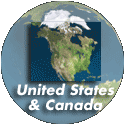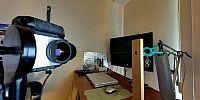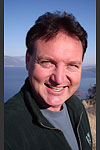
The Source of VR-Photography
Entrance Pupil, Vancouver, BC, Canada
Sunday, March 23, 2008 - 16:59 PT
© 2008 Milko K. Amorth, All Rights Reserved.
To make this virtual image visible to the human eye you have to introduce some light through the viewfinder and somewhat control the light reflections on the front of the lens glass. Look into the lens and you will see a bright disc in front of the aperture. That disc is the entrance pupil. The laser beam is directed here ~30° angled to the entrance pupil for the light ray to pass through the lens. By rotating the lens the incidental light angles (simulated with the laser beam) are increased and the entrance pupil moves forward toward the vertex of the lens. Looking at beta 60° or beta 90° into a fisheye lens this entrance pupil moves up to 1,3 cm forward from beta 0° (lens axis).
It should be noted the fact that this virtual image gets smaller as the aperture closes down. The NPP is affected by it. The powered off Canon cam here shows the aperture wide open, so the entrance pupil is quite large. In reality the aperture used with most lenses in VR-Photography is closed down considerably from that shown here for demonstration purposes.
Since this demo setup was already calibrated to beta 30° the laser point shifted forward when the angle was increased, thus introducing parallax shifts when rotated. Ordinarily one would now shift the lens back to meet that point introduced by that light beam angle to the point were it does not move anymore when the lens is rotated to the same amount of the light angle to the opposite side of the lens axis. I.e. a beta angle of 30° has a total incident angle of 60° in a no parallax region, this would allow for 6 segmental images to be stitched to a 360° panorama free of parallax. A beta 90° would give a 180° no parallax region and thus allow for 2 segmental images to be stitched to a 360° panorama.
A parallax error (more accurately motion parallax appears in the overlap region of the segment images when stitched together. Especially pronounced with objects in close range. The seam line is usually in the center of it. Depending on the amount of overlap present is the room to maneuver around it in post production via masking to make it the least visible. Modern sophisticated stitcher algorithms are capable of warping and averaging a quite impressive error range and show very little ghosting when blended (internally)to a finished panorama without the need to masking. Which makes the need of total accuracy to find the NPP seem less important to most, but nevertheless the source should not be forgotten when trouble is on the 'close range' and you must draw from the basics learned. It is the physical beginning of a stress free perfect VR-Photography.
USA-Canada / Canada-British Columbia
Lat: 49° 20' 21.84" N
Long: 124° 2' 15.6" W
Elevation: 522 ft
Precision is: High. Pinpoints the exact spot.


 Tap or click the zoom icon in the bottom right corner of the picture to switch between in-page and fullscreen view
Tap or click the zoom icon in the bottom right corner of the picture to switch between in-page and fullscreen view